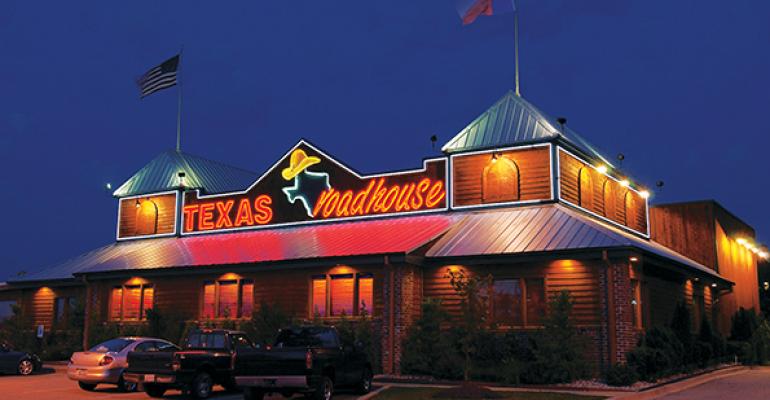While casual-dining in general has hit a speed bump, Texas Roadhouse has seen its guest counts zip along at such a healthy clip that the company has added seats to nearly a third of its 435 units in what it calls a “bump-out” program over the past six years.
For the most recent second quarter, ended July 1, the Louisville, Ky.-based company saw its same-store sales rise 2.9 percent at company-owned units and 3.6 percent at franchised restaurants.
Price Cooper, Texas Roadhouse’s chief financial officer, said the company’s average unit volume grew 2.4 percent from April to June.
Cooper credited the same-store sales increase to a split between traffic growth of 1.5 percent and check increases of 1.4 percent.
Everyday consumers are the bread and butter of Texas Roadhouse’s traffic, and the brand remains dedicated to nurturing and keeping those loyal patrons.


“About two-thirds of our revenue is driven by our loyal guests,” Travis Doster, spokesman for Texas Roadhouse, said. “They are dining with us two or more times a month.”
Providing guests with a consistent experience is crucial. “To get traffic, you have to have a relationship with your guest,” Doster said. “They need to know what they are going to get at Texas Roadhouse. … Guests are very smart. They know if what they are paying today is different from what they paid before. It’s delivering on the things we are known for, which is what we call ‘Legendary Food, Legendary Service.’”
Doster said the foundation of that guest relationship begins with the company’s partnership program, where managing partners or general managers “have skin in the game.”
Those managers, he said, “are paid on performance, so they are very motivated to keep that traffic going, whether it’s getting out in the community or driving business [in other ways]. It’s a ground game vs. an air game with national TV ads or limited-time offers. We’re not doing that. Our operators are out beating the bushes in the community and talking about Texas Roadhouse.”
Local partners also oversee the local-store marketing efforts, and each store has a designated employee, sometimes full time — or in other cases a key hourly or a service manager assigned to those duties — to make sure the Texas Roadhouse name is embedded in the community.
“We like to say we are not one giant chain; we’re a collection of individual restaurants,” Doster said. “Each restaurant has a local-store marketer who is out in schools, little leagues and different organizations to do fundraiser nights.”
The corporate team will conduct various training seminars around the nation for the designated local-store marketers and also provide international information, such as best practices and other ideas, Doster said.
Events and programs range from “Legendary Kids Nights,” with balloon animals or an ice cream-eating contest, to incentives for schools or libraries to reward children in the community who read books. They have even involved blood drives.
The local-store marketers work directly for the managing partner of the individual location. “They sit down and lay out calendars of events and which areas we focus on,” Doster said.
'We zig when others zag'
(Continued from page 1)
In addition to the managing partners and local-store marketing, Texas Roadhouse credits its value-positioning for stabilizing the third leg of its traffic strategy. Doster said the brand doesn’t look just at price in the value equation, but also the service component — which he said helped the brand during the Great Recession.
“When 2008 first hit, we didn’t cut labor, we didn’t cut portion sizes,” Doster said. “We didn’t say all of a sudden that salads are an upcharge or we’re not going to give peanuts away.
“Our thing was to keep that foundation,” he said. “Consumers like consistency, and that has really helped us. They are getting the same service and the same made-from-scratch food.”
Those three elements have led the company to continue adding seats to existing units in its so-called “bump-out” program, which helps busy units reduce wait times and accommodate more guests.
As of late August, Texas Roadhouse had completed 132 bump outs over a five- to six-year span, adding 25 to 35 seats in each of the updated restaurants. Average seating in the Texas Roadhouse system is 256, Doster said.
While the company has eyed tabletop technology to help in guest payments, like those used by competitors Chili’s Grill & Bar and Appleebee’s Neighborhood Grill & Bar, it has decided not to implement that into for now, Doster said.
“We zig when others zag,” he said. “We won’t cut when everybody else is, because that compromises the guest experience. Our servers have three-table stations. We could easily say, ‘We’ll go to four tables.’ [The technology] might save us money, but guests would recognize that.”
Overall, Texas Roadhouse’s traffic success lies in its hometown approach, Doster said.
“One of our managing partners said, ‘Other restaurant concepts teach you how to run a restaurant; Texas Roadhouse teaches you how to own one,’” he said. “You’ll treat something a lot different if you have some ownership in it. You’re going to beat the bushes to get that traffic in there.”
Texas Roadhouse has 433 units in 49 states and three foreign countries.
Contact Ron Ruggless at [email protected].
Follow him on Twitter: @RonRuggless





